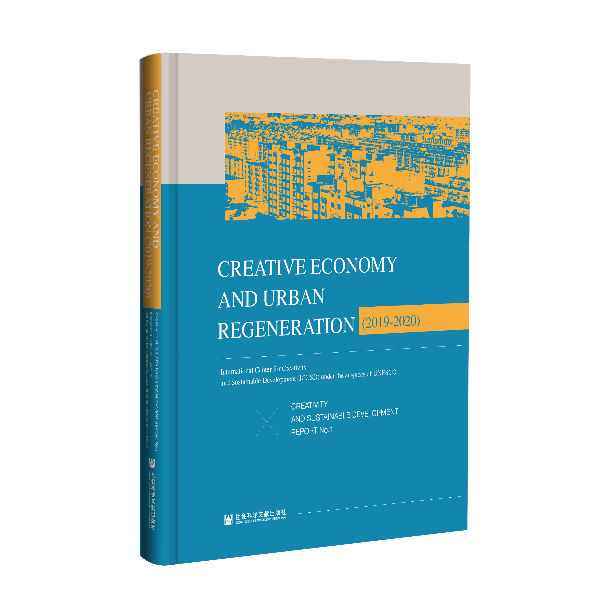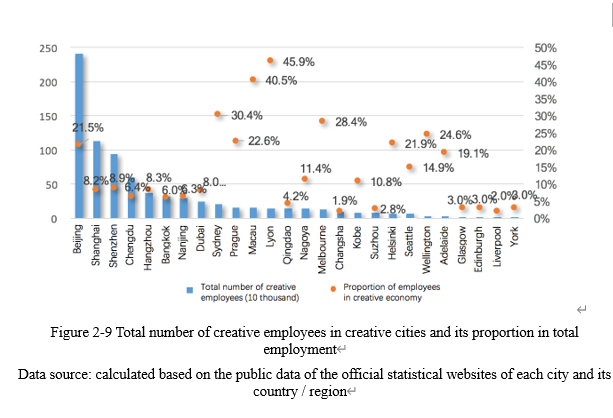Recently, UNESCO International Center for Creativity and Sustainable Development (ICCSD) released Creative Sustainable Development Index(CSDI) and the initial results of the Index research. As the first combination of creativity impetus promoted by UNESCO and the UN's core concept of sustainability, the Index has built a research framework for the role of creativity and innovation in urban sustainable development by detailed data analysis. It also addressed the intermediary linking the two fields.
As an observer of UNESCO Creative Cities Network (UCCN), ICCSD has always been working on interdisciplinary research relating to creative cities, the creative economy and sustainable development, aiming to provide creative solutions for urban growth globally. The professional team of ICCSD Index research has brought in senior experts from top-class research institutes at home and abroad.

Creativity and Sustainable Development Report No. 1: Creative Economy and Urban Regeneration (2019-2020)
Source: Social Sciences Academic Press (China)
The Highlights of the Report: 31 Cities, 5 Indicators and 4 Insights
The United Nations declares 2021 as the International Year of Creative Economy for Sustainable Development intending to advance the creative economy that is often misunderstood and misrepresented and recognize the critical role of the creative economy in promoting sustainable development. The United Nations Conference on Trade and Development (UNCTAD) figured that in a post-pandemic world, the creative economy, which is finally having its day – or more accurately, year – in the sun, will contribute hugely to economic recovery. The proposal for the advancement of the creative economy was backed by 81 countries
CSDI Index presents a further achievement of the UN's appeal for the promotion of the creative economy in the field of urban development. On the basis of the traditional creative industries index, the new release goes deeper and consists of four first-level indicators, eight second-level indicators and twenty third-level indicators considering the inner link between cultural creativity and technological innovation industry index and the Sustainable Development Goals (SDGs). On top of that, it studies 246 member cities of UCCN and other major cities, intending to measure and monitor the contribution of creative industries to the 17 SDGs, which are the core of the 2030 Agenda for Sustainable Development, in cities.
The book "Report No. 1", basing the quantitative analysis on the data sample of the world 31 major creative cities (Sydney, Adelaide, Beijing, Shenzhen, Edinburgh, Lyon, Seattle, etc.), evaluates the contribution of the creative economy in cities to SDG 8: Decent Work and Economic Growth, and puts forward four insights.
In terms of economic growth, the direct contribution of the creative economy in more than 60% of the creative cities exceeds 10% of GDP and is above the country's average level in over 70% of the cities. Particularly, Sydney and Adelaide of Australia have distinctive advantages, with a contribution of 50.5% and 43.6%. Among 14 China's creative cities, the direct contribution of the creative economy to the economy in Beijing and Shanghai is higher than the international average.

In terms of decent work, the employees of creative industries in nearly half of the creative cities account for more than 10% of the total employed population, and in over 70% of the cities, the employment rate of the creative industries is above the country's average level. As creative cities, UCCN members are playing the leading role in the employment of the country's creative industries and serve as a model for the whole world.

Although in creative cities there is a positive correlation between the population, economic development and the scale of the creative economy, the contribution made by the creative economy to GDP displays no striking correlation with city size. Economic growth and sustainability can be achieved through encouraging, supporting and guiding the development of the creative economy, be it in large or small cities. From this point, the creative economy driving urban economic development is universal.
Per capita GDP in most creative cities is directly proportional to employment and reflects the level of social development and the impact of social equality on the employment of creative industries to a certain degree. Therefore, the creative industries' employment is a mirror of urban sustainable development. As the creative economy is more elastic, the siphonage of economic industries in Beijing, Shanghai, Dubai, Sydney and Adelaide is more effective in employment. Urban sustainable development in the economy and society can derive benefits from more occupations in creative industries.
In cities with available data of trades, information transmission, software and IT services and scientific research and technology services make substantial contributions to the GDP of the creative economy. And the contribution in creative cities around the world comes to more than 80%. The contribution of culture, sports and entertainment on average is less than 10%. These data reflect the built-in tendency of industry development that integrates science and technology and culture. It is urgent to integrate culture, art and entertainment with scientific research and emerging technology to increase the added value.
The scientific research and technology services in global creative cities provides the most jobs, accounting for about 40%-70% of the total employment in the creative economy, among which the ratio in Wellington and Sydney is 73.32% and 72.6% respectively. The employment in more than 70% of China's creative cities has a proportion as high as 40% in information transmission and software and IT services, particularly in Nanjing (63.8%) and Hangzhou (60.78%). Information service and scientific research and technology services split the employment 50-50 in Beijing and Shanghai.
According to the latest UCCN member cities by 2019, China is home to the most creative cities. Among all the creative cities, 13 out of 14, except Shunde, are at or above the prefectural level. Of the total creative cities around the world, medium and small cities are the majority. Comparatively speaking, the population and the size of China's creative cities are larger than other creative cities. Therefore, these cities have their own specialties in terms of the creative economy.
As municipalities directly under the Central Government, Beijing and Shanghai have more benefits in the resources of scientific research and culture and have a higher proportion of the creative economy. As capital cities, Hangzhou, Changsha and Chengdu gather the quality resources within the province. The rank of the proportion of creative industries nationwide is consistent with the per capita GDP of these cities. Though Shenzhen and Suzhou share higher per capita GDP, as two centers of traditional manufacturing, the resources of culture and scientific research are dwarfed by the rich manufacturing resource, which results in a smaller proportion of the creative economy than other cities. The layout of urban industries and the resource concentration of culture and scientific research are of primary importance to the development of the creative economy in China's creative cities.

Looking forward, worldwide creative cities and the development of the creative economy still have a long way to go and face a profusion of opportunities and challenges. Will the cultural resource embodied in the creative economy be made good use of? How could culture and arts integrate with technological innovation and climb on the bandwagon of digital technology to achieve better development? To what extent do the jobs and creative growth brought by the creative economy improve social equality? Can the creative economy empower the vulnerable in poor areas? ICCSD will continuously follow the development of UCCN and probe into the role of the creative economy in urban sustainable development by quantitative and qualitative analysis.
The print editions of Creativity and Sustainable Development Report No. 1: Creative Economy and Urban Regeneration (2019-2020) (Chinese & English version) published by Social Sciences Academic Press (China) have been published simultaneously with the ebook globally. Currently, it can be bought on online platforms like Kindle, JD, Taobao and Dangdang.
More results are made public in the series of Creativity and Sustainable Development Report.